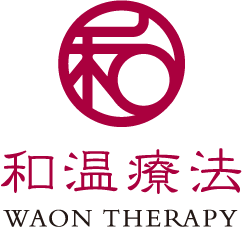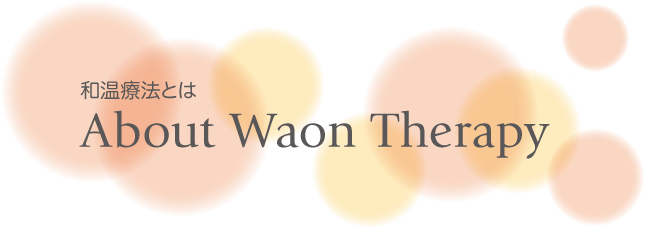
Waon therapy literally means “soothing warm therapy,” and it is a kind of healing approach in which your entire body is comfortably warmed. This method was originally developed as a thermal therapy for chronic heart failure in 1989. In March 2007, I changed the name from the previous one to Waon therapy to differentiate it from the traditional thermal therapy that is often practiced using heat as a local treatment for cancer, and also to reflect the accurate meaning of our soothing warm therapy. Since then, Wnaon therapy came to be well kown both domestically and abroad. The word “Waon” is a term that I coined, and it has the meaning of “soothing and warmth.”
As the name indicates, Waon therapy is extremely safe and free from any adverse effects. It is particularly useful for people who suffer from various kinds of intractable diseases and those who cannot exercise due to complications such as bone and joint diseases, cerebral vessel disorders, and so on. Most of these people do not have chance to sweat comfortably. Waon therapy helps them to have a refreshing sweat; to coordinate various matters such as mood, appetite, sleep, and normal bowel movements; and to alleviate a depressed state. Whether it is Western medicine or traditional Asian medicine, patients who undergo established treatments are forced to bear the pain or to exercise patience as a matter of course. Waon therapy, however, which is comfortable itself, brings back color to patients and makes them smile. Indeed, it is a therapy that is soothing and warm.
Waon therapy is performed as follows: for 15 minutes patients are placed in a far-infrared-ray dry sauna, which is evenly maintained at 60 degrees centigrade; subsequently they are kept on a bed to rest with sufficient warmth using blanket for an additional 30 minutes outside the sauna room. Lastly, oral hydration with water is used to compensate for water lost due to perspiration. With a 15-minute dry sauna maintained at 60 degrees centigrade, the deep-body temperature increases 0.8 to 1.2 degrees centigrade. This increase of around 1.0 degree centigrade in the deep-body temperature is safe and free of adverse effects, and it shows therapeutic effects. Waon therapy improves vascular function in the entire body. It dilates arteries and veins to decrease vascular resistance and reduces cardiac preload and afterload, resulting in an increase of stroke volume and cardiac output to promote blood circulation.
Waon therapy improves vascular endothelial function and has effects on angiogenesis. It clearly intensifies the production of nitric monoxide (NO), which is closely related to these actions, and heat shock protein, which is a kind of stress induced protein that exercises a biological defense mechanism. This means that Waon therapy has anti-atherogenic action, increasing systematic blood flow and thus supplying necessary nutrition—oxygen—to each of the organs’ cells. This is why Waon therapy applies clinically in broad ways, and demonstrates remarkable effects on alleviating and preventing many types of intractable diseases.
Twenty-five years have passed since I began developing Waon therapy. So far I have uncovered numerous facts through a number of clinical studies and basic research projects. I actually experienced a number of surprising cases in which Waon therapy helped patients recovering from intractable illnesses that were resistant to conventional therapies such as drug intervention. To name a few: chronic heart failure, in which the patient cannot be released from hospital due to serious heart failure that is treatable with heart transplant; peripheral arterial disease, which is treated with lower-limb amputation due to intractable ulcers and aching pain; chronic fatigue syndrome, which prevents patients from returning to society due to unexplained severe fatigue; chronic pain or fibromyalgia syndrome, which afflicts patients for prolonged periods; and so on. By adding or combining Waon therapy with traditionally established treatments, including pharmacological treatment, significant therapeutic effects are shown.
Today’s medical services are practiced based on each of the internal organ, and diagnosis and treatment departments for all sorts of organs and bodily systems are set up at every general hospital, including university hospitals. Medical service is actually provided in each of these specialized areas. Contrary to this, Waon therapy is not an organ-or system- specific treatment. It promotes vascular function and neoangiogenesis of the entire body to improve overall blood circulation, and therefore it can work together with any treatment department in any organ or bodily system category. Furthermore, Waon therapy corrects central and peripheral autonomic nerves and neuro-humoral factors (hormonal activity), activates autoimmunity and biological defense mechanisms, and soothes both the heart and the spirit to provide patients with both physical and mental refreshment. Indeed, it is a holistic medical care. Waon therapy, therefore, is not only an effective method to treat various kinds of intractable diseases but can also slow the progression of illnesses if the treatment is applied at an early phase. Furthermore, it will prevent causative diseases and is effective in restoring health for everyone.
Unlike conventional treatment methods, Waon therapy is an innovative approach to treatment. Japan has the highest life expectancy rate in the world, and this phenomenon will continue to progress into an ultra-aged society. The kind of medical care essential to such an aged society is holistic medicine. It would be ideal if the life of every person in the country ended with a sense of satisfaction after a long life, and if each person lived while maintaining their personal quality of life until drawing their final breath. We would call such an ideal society a social world with a happy long life. To realize such a world, medical care for a happy long life becomes necessary. In July 2012, Health Japan 21 (2nd edition) was implemented by the Ministry of Health, Labour and Welfare of Japan, and good health and long life are promoted as a national policy. Good health and long life, needless to say, are wonderful for anyone, but good health will be impaired someday, and people have to experience a period of nursing care before the end of life. It could be said that a life was satisfactory if the person could experience the period of receiving nursing care in happiness. Waon therapy not only promotes good health and long life but also contributes to a fulfilled time in nursing care. Waon therapy is an approach that will be great news for elderly people who need long-term nursing care, and for people with severe illnesses. It truly is medical care for a happy long life.
Waon therapy is safe, highly cost-effective, and is a kind comprehensive treatment method for patients because of its soothing power and the fact that it prompts a refreshing positive perspiration. It is different from traditional treatment methods, which come with pain and the need for patience. I believe Waon therapy will become a novel treatment method for the 21st century, and will come as truly good news for as many patients as possible along with their family members.




